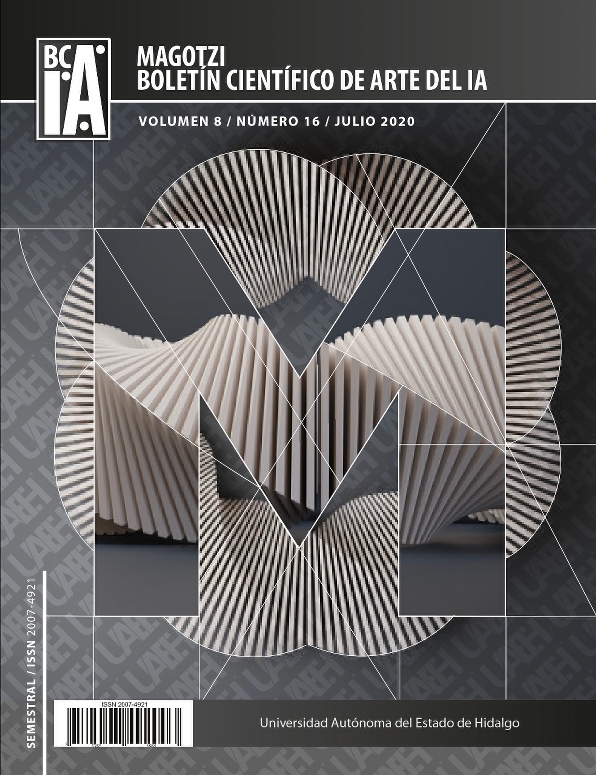Towards an Iconography of the Dismembered Body
Abstract
The article is an iconographic essay on the motif of the dismembered body. Due to the ubiquitous presence of images of dismembered bodies in the Mexican media, the author analyses the meanings this motif has conveyed, in order to understand the way images of dismemberment operate to produce an emotional reaction in the viewer. Influenced by the methods of the science of the image in German Scholarship (Bildwissenschaft), the article advances the application of an iconographical method to address the way images of violence operate.
Downloads
References
Agamben, G. (1997). Homo sacer. Paris: Seuil.
Agamben, G. (1999). Aby Warburg and the Nameless Science. In G. Agamben, & D. Heller-Roazen, Potentialities: Collected essays in philosophy (pp. 89-103). Stanford, Cal.: Stanford University Press.
Barrios Lara, J. L. (1998). El cuerpo fragmentado. In J. Soler Frost, El cuerpo Aludido. Anatomías y construcciones (pp. 173-182). México: Patronato del Museo Nacional de Arte, CONACULTA, INBA.
Baudelaire, C. (2010). The painter of modern life and other essays (J. Mayne, Trad.). London: Phaidon Press. (Original work published 1863)
Belting, H. (2007). Likeness and presence: A history of the image before the era of art. Chicago: University of Chicago Press.
Belting, H. (2011). An anthropology of images: Picture, medium, body. Princeton: Princeton University Press.
Belting, H. (2016) Iconic Presence. Images in Religious Traditions. Material Religion, 12(2), 235-237.
Bredekamp, H., (2018). Image acts: A systematic approach to visual agency (E. Clegg, Trad.). Berlin: De Gruyter.
Bremmer, J. N. (1984). Greek maenadism reconsidered. Zeitschrift für Papyrologie und Epigraphik, 55, 267-286.
Burkert, W. (1983). Homo necans: The anthropology of ancient Greek sacrificial ritual myth. Berkeley: University of California Press.
Bynum, C. W. (1991). Fragmentation and redemption: Essays on gender and the human body in medieval religion. New York: Zone Books.
Bynum, C. W. (1995). The Resurrection of the Body in Western Christianity, 200-1336. New York: Columbia University Press.
Carruthers, L. (2011). A Persian Martyr in a Middle English Vernacular Exemplum: The Case of St James Intercisus. Medieval Sermon Studies, 55(1), 13-30.
Cué, L., Carrizosa, F., & Valentín, N. (2010). El monolito de Coyolxauhqui: investigaciones recientes. Arqueología mexicana, 17(102), 42-47.
Devos, P. (1953). Le dossier hagiographique de S. Jacques l'Intercis. I: La Passion grecque inédite (BHG. 772). Analecta Bollandiana 71, 157-210. https://doi.org/10.1484/J.ABOL.4.02358
Diéguez, I. (2013) Cuerpos sin duelo: Iconografía y teatralidades del dolor. Córdoba, Argentina: Ediciones DocumentA/Escénicas.
Diers, M., Girst, T., & von Moltke, D. (1995). Warburg and the Warburgian tradition of cultural history. New German Critique, 65, 59-73.
Dodds, E. R. (1940). Maenadism in the Bacchae. Harvard Theological Review, 33(3), 155-176.
Euripides (1944) Bacchae (E.R. Dodds, ed.). Oxford: Clarendon Press. (Original work published ca. 405 B.C.E.)
Forster, K. W., (1996). Aby Warburg: his study of ritual and art on two continents (D. Britt, Trans.). October, 77, 5-24.
Freedberg, D. (1989). The power of images: Studies in the history and theory of response. Chicago: University of Chicago Press.
Freiberg, J. (2009). Pope Gregory XIII, Jurist. Memoirs of the American Academy in Rome, 54, 41-60.
Frisby, D. (1985) Fragments of Modernity : Theories of Modernity in the Work of Simmel, Kracauer and Benjamin. Cambridge: Polity Press.
Girard, R. (1977). Violence and the sacred (P. Gregory, Trans.). Baltimore: Johns Hopkins University Press.
González de Lesur, Y. (1968). El dios Huitzilopochtli en la peregrinación mexica: de Aztlán a Tula. In Anales del Instituto Nacional de Antropología e Historia, 19, 175-190.
González Mello, R. (2001). La victoria impía. Edmundo O'Gorman y José Clemente Orozco. In R. Eder (Ed.), El Arte en Mexico: autores, temas, problemas (pp. 273-302). México: Fondo de Cultura Económica.
Henrichs, A. (1984). Loss of Self, Suffering, Violence: The Modern View of Dionysus from Nietzsche to Girard. Harvard Studies in Classical Philology, 88, 205-240.
Jacobus, de Voragine, (2012). The Golden Legend: Readings on the Saints (W.G. Ryan, Trans.). Princeton, N.J.: Princeton University Press. (Original work published ca. 1260)
Krieger, P. (1999). Las posibilidades abiertas de Aby Warburg. In L. Enríquez Rubio (Ed.), (In) disciplinas: Estética e Historia del arte en el cruce de los discursos, XXII coloquio de Historia del Arte (pp. 261-280). México: Universidad Nacional Autónoma de México.
Maihold, G. (2011). Las comunicaciones criminales: el caso de las Narcomantas. In S. Aguayo, & R. Benítez (Eds.), Atlas de la seguridad y la defensa de México 2012 (pp. 83-92) . México: Colectivo de Análisis de la Seguridad con Democracia.
Matos Moctezuma, E. (1990). Las seis Coyolxauhqui: variaciones sobre un mismo tema. Estudios de Cultura Náhuatl, 21, 115-30.
Mbembe, J. A., (2003). Necropolitics (L. Meintjes, Trans.). Public culture, 15(1), 11-40.
Mendoza Rockwell, N. (2016). Narco-mantas o el confín de lo criminal. Acta poética, 37(2), 21-34.
Moxey, K. (2008). Visual studies and the iconic turn. Journal of Visual culture, 7(2), 131-146.
Musei Vaticani (2020, March) Sala di Constantino. http://www.museivaticani.va/content/museivaticani/it/collezioni/musei/stanze-di-raffaello/sala-di-costantino/stanza-di-costantino.html
Nochlin, L. (1994). The body in pieces: The fragment as a metaphor of modernity. London: Thames and Hudson.
Pingeot, A., dir. (1990). Le corps en morceaux. Paris: Musée d'Orsay-Editions de la Réunion.
Rampley, M. (2012). Bildwissenschaft: theories of the image in German-language scholarship (pp. 119-134). In Art History and Visual Studies in Europe. Leiden: Brill.
Sahagún, B. (1989). Historia general de las cosas de Nueva España: Vol 1 (A. López Austin, & J. García Quintanar, Eds.). México: CONACULTA. (Original work published 1577)
Scolieri, P. (2004). Coyolxauhqui's impact: Aztec historiography and the falling body. Women & Performance: A Journal of Feminist Theory, 14(1), 91-106.
Ter Borg, M. B. (2011). Religion and Power. In P. Clarke (Ed.), The Oxford Handbook of the Sociology of Religion (pp. 194-209). Oxford: Oxford University Press.
Weaver, B. (2009). Euripides’ Bacchae and classical typologies of pentheus’ sparagmos. 510-406 BC. Bulletin of the Institute of Classical Studies, 52, 15-43.











